AHFS/Drugs.com Monograph License data US FDA: Quinine CAS ID 130-95-0 | MedlinePlus a682322 Formula C20H24N2O2 | |
 | ||
Pronunciation US /ˈkwaɪnaɪn/, /kwɪˈniːn/ or UK /ˈkwɪniːn/ KWIN-een Trade names Qualaquin, Quinate, Quinbisul Pregnancycategory AU: DUS: C (Risk not ruled out) | ||
Drug use gone bad quinine for leg cramps dangerous
Quinine is a medication used to treat malaria and babesiosis. This includes the treatment of malaria due to Plasmodium falciparum that is resistant to chloroquine when artesunate is not available. While used for restless legs syndrome, it is not recommended for this purpose due to the risk of side effects. It can be taken by mouth or used intravenously. Malaria resistant to quinine occurs in certain areas of the world. Some quantities are also used in tonic water and gives it its bitter taste.
Contents
- Drug use gone bad quinine for leg cramps dangerous
- Medical
- Available forms
- Beverages
- Scientific
- Contraindications
- Adverse effects
- Mechanism of action
- Chemistry
- Synthesis
- Natural occurrence
- History
- Regulation
- Cutting agent
- Other animals
- References
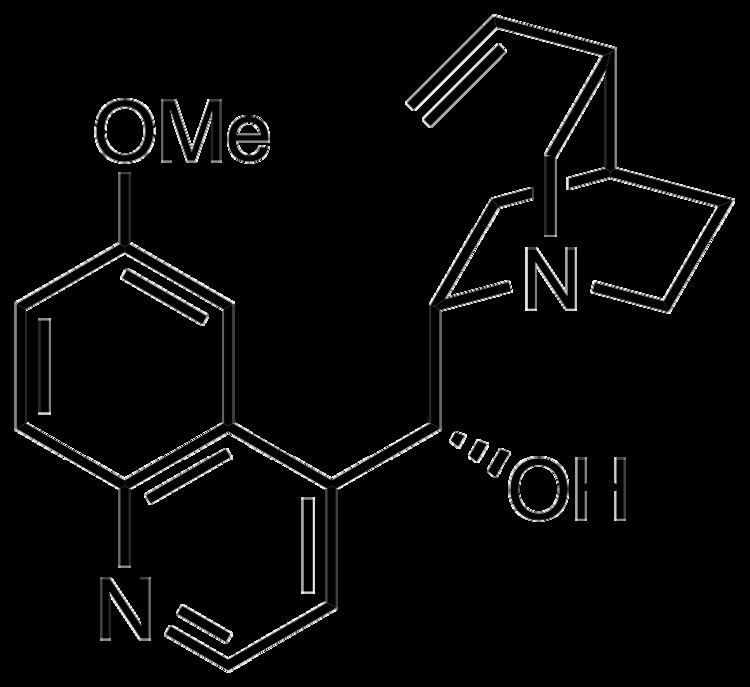
Common side effects include headache, ringing in the ears, trouble seeing, and sweating. More severe side effects include deafness, low blood platelets, and an irregular heartbeat. Use can make one more prone to sunburn. While it is unclear if use during pregnancy causes harm to the baby, use to treat malaria during pregnancy is still recommended. How it works is not entirely clear. It is an alkaloid.
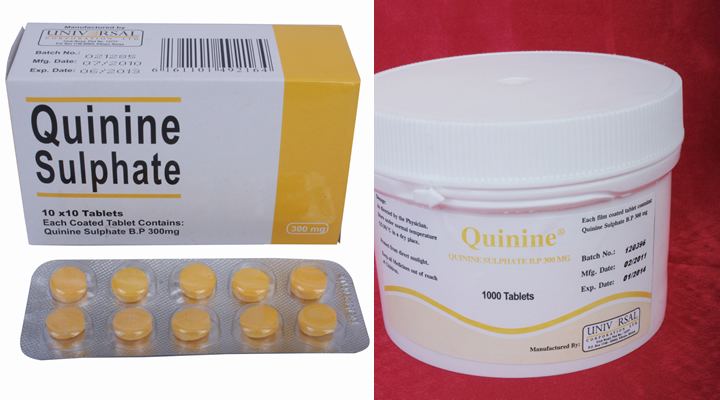
Quinine was first isolated in 1820 from the bark of a cinchona tree. Bark extracts have been used to treat malaria since at least 1632. It is on the World Health Organization's List of Essential Medicines, the most effective and safe medicines needed in a health system. The wholesale price in the developing world is about US$1.70 to $3.40 per course of treatment. In the United States a course of treatment is more than $200.

Medical
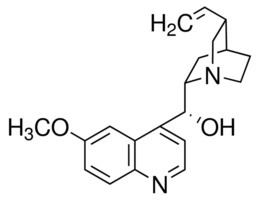
As of 2006, it is no longer recommended by the WHO (World Health Organization) as a first-line treatment for malaria, and it should be used only when artemisinins are not available. Quinine is also used to treat lupus and arthritis.
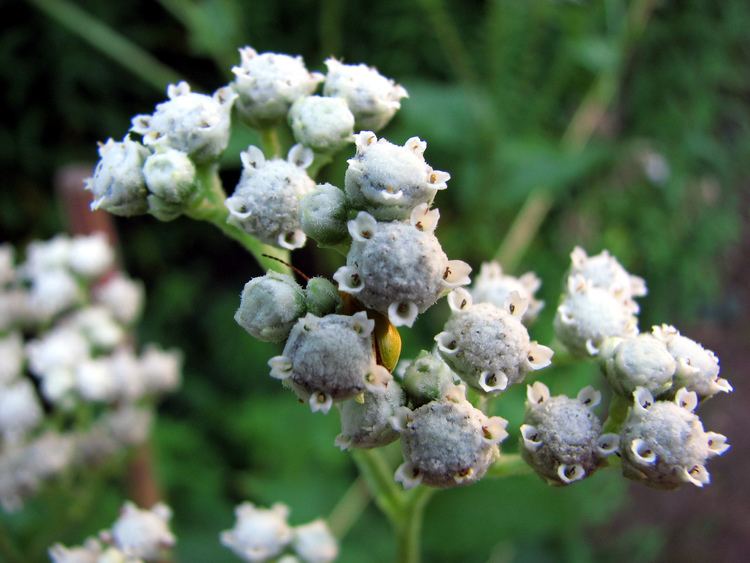
In the past, quinine was frequently prescribed in the US as an off-label treatment for nocturnal leg cramps, but this has become less prevalent due to a Food and Drug Administration statement warning against the practice.
Available forms
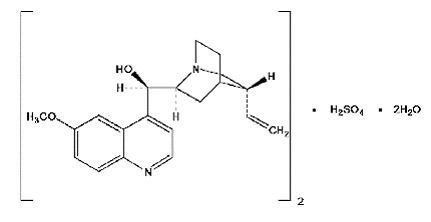
Quinine is a basic amine and is usually provided as a salt. Various existing preparations include the hydrochloride, dihydrochloride, sulfate, bisulfate and gluconate. In the United States, quinine sulfate is commercially available in 324-mg tablets under the brand name Qualaquin.
All quinine salts may be given orally or intravenously (IV); quinine gluconate may also be given intramuscularly (IM) or rectally (PR). The main problem with the rectal route is that the dose can be expelled before it is completely absorbed; in practice, this is corrected by giving a further half dose. No injectable preparation of quinine is licensed in the US; quinidine is used instead.
Beverages
Quinine is a flavour component of tonic water and bitter lemon drink mixers. On the soda gun behind many bars, tonic water is designated by the letter "Q" representing quinine.
According to tradition, the bitter taste of anti-malarial quinine tonic led British colonials in India to mix it with gin, thus creating the iconic gin and tonic cocktail, which is still popular today. Quinine is an ingredient in both tonic water and bitter lemon. In the US, quinine is listed as an ingredient in some Diet Snapple flavors, including Cranberry-Raspberry.
In France, quinine is an ingredient of an apéritif known as quinquina or "Cap Corse". In Spain, quinine ("Peruvian bark") is sometimes blended into sweet Malaga wine, which is then called "Malaga Quina". In Italy, the traditional flavoured wine Barolo Chinato is infused with quinine and local herbs and is served as a digestif. In Canada and Italy, quinine is an ingredient in the carbonated chinotto beverages Brio and San Pellegrino. In Scotland, the company A.G. Barr uses quinine as an ingredient in the carbonated and caffeinated beverage Irn-Bru. In Uruguay and Argentina, quinine is an ingredient of a PepsiCo tonic water named Paso de los Toros. In Denmark, it is used as an ingredient in the carbonated sports drink Faxe Kondi made by Royal Unibrew.
In some areas, non-medical use of quinine is regulated. For example, in the United States and Germany, quinine is limited to between 83 and 85 parts per million.
Scientific
Quinine (and quinidine) are used as the chiral moiety for the ligands used in Sharpless asymmetric dihydroxylation as well as for numerous other chiral catalyst backbones. Because of its relatively constant and well-known fluorescence quantum yield, quinine is used in photochemistry as a common fluorescence standard.
Contraindications
Quinine can cause abnormal heart rhythms, and should be avoided if possible in patients with atrial fibrillation, conduction defects, or heart block. Quinine can cause hemolysis in G6PD deficiency (an inherited deficiency), but this risk is small and the physician should not hesitate to use quinine in patients with G6PD deficiency when there is no alternative.
Adverse effects
Quinine can cause unpredictable serious and life-threatening blood and cardiovascular reactions including low platelet count and hemolytic-uremic syndrome/thrombotic thrombocytopenic purpura (HUS/TTP), long QT syndrome and other serious cardiac arrhythmias including torsades de pointes, blackwater fever, disseminated intravascular coagulation, leukopenia, and neutropenia. Some people who have developed TTP due to quinine have gone on to develop kidney failure.
It can also cause serious hypersensitivity reactions include anaphylactic shock, urticaria, serious skin rashes, including Stevens-Johnson syndrome and toxic epidermal necrolysis, angioedema, facial edema, bronchospasm, granulomatous hepatitis, and itchiness.
The most common adverse effects involve a group of symptoms called cinchonism; almost everyone taking quinine has mild cinchonism, which can include headache, vasodilation and sweating, nausea, tinnitus, hearing impairment, vertigo or dizziness, blurred vision, and disturbance in color perception. More severe cinchonism includes vomiting, diarrhea, abdominal pain, deafness, blindness, and disturbances in heart rhythms. Cinchonism is much less common when quinine is given by mouth, but oral quinine is not well tolerated (quinine is exceedingly bitter and many patients will vomit after ingesting quinine tablets): Other drugs, such as Fansidar (sulfadoxine with pyrimethamine) or Malarone (proguanil with atovaquone), are often used when oral therapy is required. Quinine ethyl carbonate is tasteless and odourless, but is available commercially only in Japan. Blood glucose, electrolyte and cardiac monitoring are not necessary when quinine is given by mouth.
Mechanism of action
As with other quinoline antimalarial drugs, the mechanism of action of quinine has not been fully resolved. The most widely accepted hypothesis of its action is based on the well-studied and closely related quinoline drug, chloroquine. This model involves the inhibition of hemozoin biocrystallization in Heme Detoxification pathway, which facilitates the aggregation of cytotoxic heme. Free cytotoxic heme accumulates in the parasites, causing their deaths.
Chemistry
The UV absorption of quinine peaks around 350 nm (in UVA). Fluorescent emission peaks at around 460 nm (bright blue/cyan hue). Quinine is highly fluorescent (quantum yield ~0.58) in 0.1 M sulfuric acid solution.
Synthesis
Cinchona trees remain the only economically practical source of quinine. However, under wartime pressure, research towards its synthetic production was undertaken. A formal chemical synthesis was accomplished in 1944 by American chemists R.B. Woodward and W.E. Doering. Since then, several more efficient quinine total syntheses have been achieved, but none of them can compete in economic terms with isolation of the alkaloid from natural sources. The first synthetic organic dye, mauveine, was discovered by William Henry Perkin in 1856 while he was attempting to synthesize quinine.
Natural occurrence
The bark of Remijia contains 0.5–2% of quinine. The bark is cheaper than bark of Cinchona, and as it has an intense taste it is used for making tonic water.
History
Quinine was used as a muscle relaxant, by the Quechua, who are indigenous to Peru, Bolivia and Ecuador to halt shivering due to low temperatures. The Quechuas would mix the ground bark of cinchona trees with sweetened water to offset the bark's bitter taste, thus producing tonic water.
The Jesuits were the first to bring cinchona to Europe. The Spanish were aware of the medicinal properties of cinchona bark by the 1570s or earlier: Nicolás Monardes (1571) and Juan Fragoso (1572) both described a tree that was subsequently identified as the cinchona tree and whose bark was used to produce a drink to treat diarrhea. Quinine has been used in unextracted form by Europeans since at least the early 17th century. It was first used to treat malaria in Rome in 1631. During the 17th century, malaria was endemic to the swamps and marshes surrounding the city of Rome. Malaria was responsible for the deaths of several popes, many cardinals and countless common Roman citizens. Most of the priests trained in Rome had seen malaria victims and were familiar with the shivering brought on by the febrile phase of the disease. The Jesuit brother Agostino Salumbrino (1564–1642), an apothecary by training who lived in Lima, observed the Quechua using the bark of the cinchona tree for that purpose. While its effect in treating malaria (and hence malaria-induced shivering) was unrelated to its effect in controlling shivering from rigors, it was still a successful medicine for malaria. At the first opportunity, Salumbrino sent a small quantity to Rome to test as a malaria treatment. In the years that followed, cinchona bark, known as Jesuit's bark or Peruvian bark, became one of the most valuable commodities shipped from Peru to Europe. When King Charles II was cured of malaria at the end of the 17th Century with quinine, it became popular in London. It remained the antimalarial drug of choice until the 1940s, when other drugs took over.
The form of quinine most effective in treating malaria was found by Charles Marie de La Condamine in 1737. In 1820, French researchers Pierre Joseph Pelletier and Joseph Bienaimé Caventou first isolated quinine from the bark of a tree in the Cinchona genus - probably Cinchona officinalis - and subsequently named the substance. The name was derived from the original Quechua (Inca) word for the cinchona tree bark, quina or quina-quina, which means "bark of bark" or "holy bark". Prior to 1820, the bark was first dried, ground to a fine powder, and then mixed into a liquid (commonly wine) which was then drunk. Large-scale use of quinine as a prophylaxis started around 1850; for instance in 1853 Paul Briquet published a brief history and discussion of the literature on "quinquina".
It was the first effective treatment for malaria caused by Plasmodium falciparum, appearing in therapeutics in the 17th century. It remained the antimalarial drug of choice until the 1940s, when other drugs, such as chloroquine, that have fewer side effects replaced it. Since then, many effective antimalarials have been introduced, although quinine is still used to treat the disease in certain critical circumstances, such as severe malaria, and in impoverished regions, due to its low cost. Quinine is also present (in minute quantities) in various beverages. It is a white crystalline alkaloid.
Quinine also played a significant role in the colonization of Africa by Europeans. Quinine had been said to be the prime reason Africa ceased to be known as the "white man's grave". A historian has stated, "it was quinine's efficacy that gave colonists fresh opportunities to swarm into the Gold Coast, Nigeria and other parts of west Africa".
To maintain their monopoly on cinchona bark, Peru and surrounding countries began outlawing the export of cinchona seeds and saplings beginning in the early 19th century. The Dutch government persisted in its attempt to smuggle the seeds, and by the 1930s Dutch plantations in Java were producing 22 million pounds of cinchona bark, or 97% of the world's quinine production. During World War II, Allied powers were cut off from their supply of quinine when the Germans conquered the Netherlands and the Japanese controlled the Philippines and Indonesia. The United States had managed to obtain four million cinchona seeds from the Philippines and began operating cinchona plantations in Costa Rica. Nonetheless, such supplies came too late; tens of thousands of US troops in Africa and the South Pacific died due to the lack of quinine. Despite controlling the supply, the Japanese did not make effective use of quinine, and thousands of Japanese troops in the southwest Pacific died as a result.
Bromo Quinine were brand name cold tablets containing quinine, manufactured by Grove Laboratories. They were first marketed in 1889 and at least available until the 1960s.
Regulation
From 1969 to 1992, the US Food and Drug Administration (FDA) received 157 reports of health problems related to quinine use, including 23 which had resulted in death. In 1994, the FDA banned the marketing of over-the-counter quinine as a treatment for nocturnal leg cramps. Pfizer Pharmaceuticals had been selling the brand name Legatrin for this purpose. Also sold as a Softgel (by SmithKlineBeecham) as Q-vel. Doctors may still prescribe quinine, but the FDA has ordered firms to stop marketing unapproved drug products containing quinine. The FDA is also cautioning consumers about off-label use of quinine to treat leg cramps. Quinine is approved for treatment of malaria, but is also commonly prescribed to treat leg cramps and similar conditions. Because malaria is life-threatening, the risks associated with quinine use are considered acceptable when used to treat that affliction.
Though Legatrin was banned by the FDA for the treatment of leg cramps, the drug manufacturer URL Mutual has branded a quinine-containing drug named Qualaquin. It is marketed as a treatment for malaria and is sold in the United States only by prescription. In 2004, the CDC reported only 1,347 confirmed cases of malaria in the United States.
Cutting agent
Quinine is sometimes detected as a cutting agent in street drugs such as cocaine and heroin.
Other animals
Quinine is used as a treatment for Cryptocaryon irritans (commonly referred to as white spot, crypto or marine ich) infection of marine aquarium fish.
